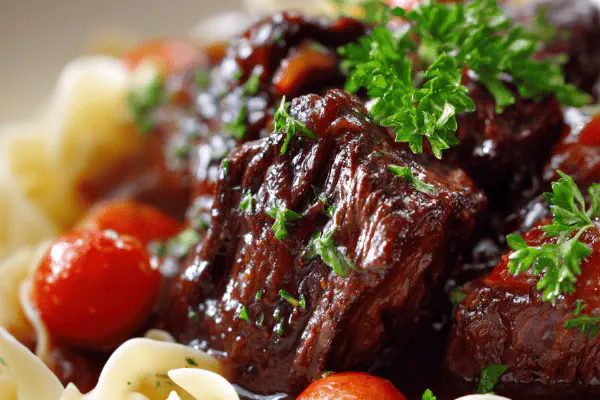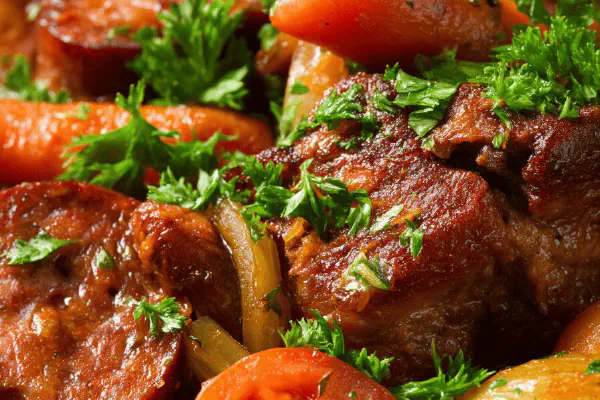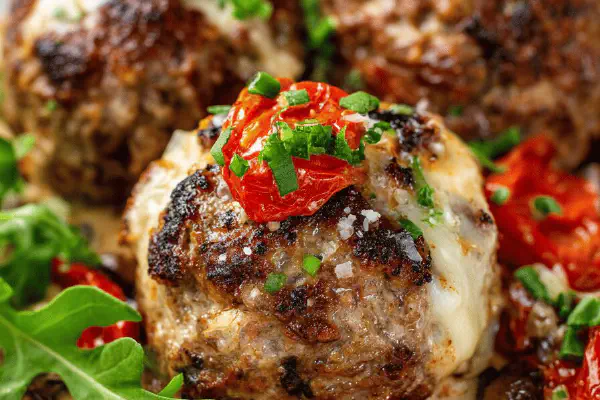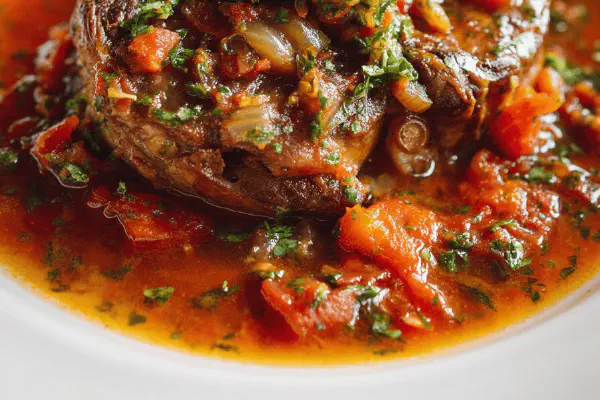Featured Recipe
Hearty Cassoulet Redux
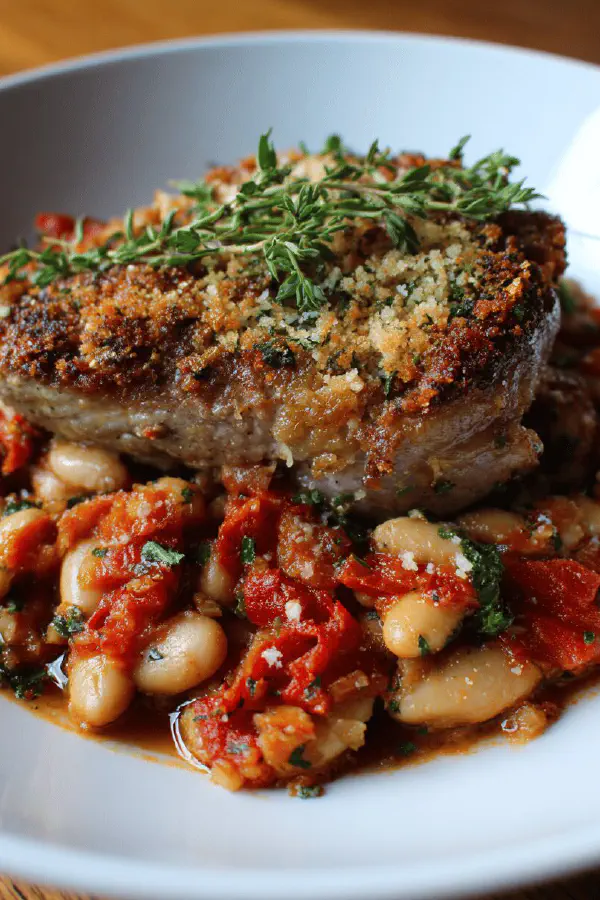
By Kate
"
White beans soaked overnight with aromatics until tender; pork chops and Toulouse sausages browned, then simmered with wine, fresh herbs, and duck confit. A rustic French stew layered with tomatoes and rich garlic sausage, slow-cooked to tender perfection. Finished under the broiler with crunchy golden breadcrumbs. Slightly tweaked for deeper flavor, replacing lard with pancetta and swapping the white wine for dry vermouth. Times and steps adjusted to emphasize technique and sensory cues, ideal for the home cook wanting mastery over every element.
"
Prep:
40 min
Cook:
Total:
Serves:
6 servings
French cuisine
comfort food
slow cooking
Introduction
Cassoulet lives in the slow lane. Forget timers. Feel the beans swelling overnight — they must be plump, hydrated but intact. Pancetta replaces traditional lard; fire-roasted flavors brought by pork fat, punch of vermouth swapped for white wine adds a fragrant herbal note. Keep sausages scored, skins cracked, else they burst and lose flavor into sauce. Browning meat first locks juices; brown bits scraped up add depth without extra seasoning. Texture is king — beans tender but whole, crust crackling under your fork, meat shredding with a spoon. Slow oven heat bakes melds pointers; much useful knowledge tucked into each hour watching the stew bubble. No shortcuts. Just layers of flavor and patience.
Ingredients
About the ingredients
Cannellini beans stand in for lingot variety, similar texture and creaminess; soak long, discard first soaking water to reduce gas-inducing sugars. Pancetta is drier and saltier than lard; blanch briefly to trim some fat but keep flavor. Vermouth over wine adds herbal punch but any dry white can work—avoid sweet or oaky styles that unbalance. Toulouse sausages bring garlic spice; if unavailable use any rustic French sausage with some fat. Garlic sausage replaces saucisson à l’ail, hold back on spices if unfamiliar or too hot. Duck confit lends richness, available pre-cooked or homemade; do not rinse before adding, fat is flavor carrier. Breadcrumbs: day-old rustic bread toasted with fresh herbs works well; store-bought can be dry and flavorless. Adjust salt after meats and duck salt their own way in.
Method
Preparing Beans
- Pour cannellini beans into a large pot with the halved onion, celery, bay leaves, minced garlic, rosemary sprigs, and blanched pancetta. Cover with cold water by at least 4 cm (1 1/2 in); soak 10 to 14 hours. This swelling phase is essential. Drain, discard soaking liquid.
- Refill pot with fresh water, again covering beans by 4 cm. Bring to a vigorous boil, then reduce heat to maintain a stubborn low simmer. Skim foam aggressively as it forms. Cook beans until tender but not mushy—test by squashing one between fingers; it should give easily but not collapse. Approximately 40 minutes, but rely on feel over clock. Salt halfway through cooking. Drain, reserve cooking liquid. Discard bay leaves, onion, celery, rosemary, pancetta.
- Preheat oven to 185°C (365°F).
- Heat heavy skillet over medium-high. Add sausage links and pork chops, drizzled with olive oil. Brown evenly until skins blister and meat caramelizes well, about 6 minutes per side. Avoid overcrowding to get proper Maillard reaction. Remove and set aside; keep hot.
- Lower heat to medium. Add chopped onion and garlic into same skillet, stir until translucent, about 3 minutes. Sprinkle flour evenly, stir constantly to form roux; cook until scent turns slightly nutty, roughly 2 minutes. Mustn’t scorch—stir nonstop.
- Deglaze pan with dry vermouth, scraping browned bits with wooden spoon. Let reduce by a third, bubbling steadily. Add reserved bean cooking liquid gradually; allow mixture to thicken with gentle boil. Once gravy coats the back of a spoon cleanly, remove from heat.
- Transfer base sauce into deep, flameproof casserole or Dutch oven. Pierce garlic sausage skin repeatedly with knife tip (keeps flavor in sauce, releases aroma). Nestle sausage chunks into sauce, add duck legs confit, browned sausages, pork chops, parsley, and carrots. Don’t stir robustly now; layer gently for even cooking.
- Spoon tender beans atop solids; evenly distribute drained tomatoes on surface. Lightly press down but don’t mash. Season with salt and cracked black pepper, remembering duck and sausage add salt.
- Cover loosely with foil or lid, place in oven. Cook low and slow for 3 hours, checking after 2 1/2 hours to ensure bubbling persists but not vigorously. Taste liquid for balance; adjust seasoning. If mixture looks dry, add reserved bean broth or water, one ladle at a time.
- Fifteen minutes before pull-out, remove lid or foil. Sprinkle crumb mixture evenly over surface. Push hot broiler or grill on high. Position cassoulet within 10 cm (4 in) of heat source. Watch carefully; breadcrumbs must toast to deep golden brown, crackling slightly. Smell toasted bread and herbs; visual cues critical to avoid burning bitter bits.
- Remove from oven. Let rest uncovered for 15 minutes before serving; flavors will marry, sauce will thicken further. Cassoulet should be rich but not soupy, with contrasting textures — soft beans, crisp crumb, tender meat falling from bones, aromatic sauce lingering on palate.
Meat and Sauce Prep
Finishing Touches
Technique Tips
Overnight soak essential for digestibility and proper cooking. Rinse and drain beans well; lingering starch inhibits even cooking. Low simmer ensures intact skins. Salt beans mid-cook to prevent toughening skins. Browning sausages and chops separately keeps flavor clean and prevents steaming—don’t overcrowd pan or meat steams instead. Roux adds thickness and body; balance cooking time here to avoid raw flour taste. Deglazing pulls fond into the sauce; slow reduction concentrates flavor. Pierce garlic sausage for perfumed release without burst. Layering rather than mixing promotes even cooking and texture contrast. Keeping casserole loosely covered during first 3 hours prevents drying but allows slow evaporation. Finishing under grill crisps crumbs for tactile contrast; watch close as raisins beyond perfect burn quickly. Resting post-cook lets sauce thicken, flavors marry better. Ideal cassoulet is hearty but balanced, not sloppy or dry—visual cues outweigh strict timings.
Chef's Notes
- 💡 Soak beans overnight. Plump and hydrated they should be. Drain well; boiling too long turns them mushy. Catching texture right key. Watch for visual cues.
- 💡 Brown meat in batches. Avoid crowding the pan. Maillard reaction crucial for flavor. Juicy and caramelized pieces matter. Keep an eye on heat to prevent burning.
- 💡 Roux needs constant stirring. No burning allowed. Cook until nutty smell arises; this rich base is what thickens the sauce. Don't rush or skip that step.
- 💡 If sauce looks thin post-bake, transfer to stovetop. Medium heat reduces it nicely. Stir until desired thickness; care with heat not to scorch any flavor.
- 💡 Breadcrumbs: stale bread works best. Toast them earlier, add herbs—results in more flavor. Watch closely under broiler, don’t want burnt bits ruining texture.
Kitchen Wisdom
Why soak the beans?
Reduces gas-inducing sugars, helps with digestibility. Plus, plump beans cook better. Better texture overall.
Can I use different sausages?
Sure; rustic or garlic sausage works. Adjust spices to taste. But Toulouse gives that classic feel.
What if I can't find duck confit?
Braised duck thighs work. Adjust cook time accordingly. Make sure to keep some fat for flavor.
How do I store leftovers?
Fridge keeps them fine for few days. Reheat gently. Add broth if too thick. Freezing works too; defrost carefully.
